The Wheelchair Guide
Your Wheelchair and Mobility Scooter Resource
Electric Wheelchairs and How They Are Put Together
October 5th, 2009
Wheelchairs are very powerful tools that have a history dating back thousands of years. However, most of the technology behind the modern wheelchair, with of course the exception of the wheel itself, is much newer. Instead, the modern manual wheelchair based off of the E&J design, which is characterized by a lightweight hollow tubed frame, which can be folded when not in use.
Today, manual wheelchairs remain incredibly popular, but the electric wheelchair is also a very common choice for the wheelchair user. Not too surprisingly, the modern electric wheelchair also has its roots in the E&J Wheelchair design. This is because the first electric wheelchairs were simply E&J wheelchairs that had been outfitted with an electric motor. Early manufacturer would sell electric conversion kits designed for use with the E&J design, but today the electric wheelchair has a significantly different design that to that of a manual wheelchair.
Most modern electric wheelchairs, which are often called power chairs, feature a relatively small base, which is covered in molded plastic. The base contains the electric motor, wiring, wheel base, and rechargeable batteries of the wheelchair. Some are quite small, while others have a much large wheel base, resulting in a much larger wheelchair. Attached to the top of the wheelchair base is a chair, which can usually be swiveled to make entering or exiting the wheelchair much easier.
The reason the base of an electric wheelchair is so small, especially when compared to that of a mobility scooter, is that by design a wheelchair must be able to be driven directly up to a table or desk, without requiring its user to transfer to another chair or a bench. For heavy duty electric wheelchairs, the base is usually larger, but it is still designed so that the power chair can be driven directly up to a desk.
Rear-Wheel Drive Wheelchairs
The number of wheels on a power chair is one way that they are classified. Rear wheel drive wheelchairs usually have a set of wheels in the front and a set of wheels in the back. The rear wheels are responsible for moving the wheelchair and are slightly larger than the front wheels, which are typically there for support only.
One of the advantages of a rear-wheel drive power chair is that they are very stable. The weight of the user is spread out more evenly around the base of the chair, resulting in a very stable wheelchair.
Mid-Wheel Drive Wheelchairs
The Mid-Wheel Drive Wheelchair actually has three sets of wheels. The front set and rear set are much smaller and are designed to provide stability and support. It is the mid wheels that are responsible for moving and turning the wheelchair, which offers the advantage of greatly improved maneuverability. This is an important feature, as many wheelchair users rely on their power chair for indoor use.
However, it is at the expense of the extra stability offered by a rear-wheel drive power chair. This is because most of the weight is placed on the mid-wheel, which significantly changes the wheelchairs center of balance. This is not to say that mid-wheel drive wheelchairs are unstable, simply that they are less stable than rear-wheel drive wheelchairs. As a result, for outdoor use or high weight capacity, a rear-wheel drive power chair will usually provide better service.
How Manual Wheelchairs Work
October 2nd, 2009
Wheelchairs have been around, albeit in a much less standard form, for thousands of years. Their roots can be traced back to images of ancient oriental devices, which were designed to provide a way for those who could not walk to get around. Today, despite there being a great number of wheelchair manufacturers around, the general design of the manual wheelchair has become much more standardized.
The modern manual wheelchair is based off of the more than 70 year old E&J wheelchair design, which features a hollow metal tube frame, two large rear wheels, and a smaller set of front wheels. When not in use, the frame can be folded, making it easier to transport and move the wheelchair.
Standard Manual Wheelchair Design
 The large rear wheels allows the user of the wheelchair to self-propel, grasping the rear wheels, which have an extended rim, called a handrim, that does not come in contact with the ground and user to spin the rear wheels.
The large rear wheels allows the user of the wheelchair to self-propel, grasping the rear wheels, which have an extended rim, called a handrim, that does not come in contact with the ground and user to spin the rear wheels.
Even though many manual wheelchairs are designed to be self propelled, this is not always the case. Some manual wheelchairs, called transport wheelchairs or transfer wheelchairs, are designed only to be pushed from behind, so feature much smaller rear wheels. They also have a set of push handles that extend from the top of the wheelchair frame, on both corners of the top seat. Most manual wheelchairs also include these push handles, although sports wheelchairs frequently do not.
The front rigging of the manual wheelchair refers to the footrest and supports, which can often be removed and adjusted to increase comfort. The front rigging varies by wheelchair, but most provide a metal foot rest, which can be folded up to allow the wheelchair user to enter and exit the chair.
A braking system is also present on most standard manual wheelchairs, although sports wheelchairs, which have a slightly different design in general, often do not include brakes. When brakes are present, however, they usually use a simple design that holds the rear wheels in place using a simple vice, which is applied separately to both wheels. This allows the person using the wheelchair to easily set the brake, with only a little pressure.
Anti-tip casters are another important feature, which extend from the rear of the wheelchair frame. They are basically like little arms, which are designed to make contact with the ground if the wheelchair tips over too far backwards. The anti-tip casters can not always prevent a fall, but they often make tipping over backwards much less dangerous.
Sports Wheelchairs vs Manual Wheelchairs
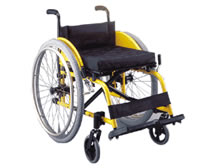 More and more, the sports wheelchair is becoming popular, not just for those who play wheelchair sports, such as wheelchair basketball or wheelchair racing, but also those who simply find sports wheelchairs more comfortable and practical. One major difference between sports wheelchairs and manual wheelchairs is the seat design.
More and more, the sports wheelchair is becoming popular, not just for those who play wheelchair sports, such as wheelchair basketball or wheelchair racing, but also those who simply find sports wheelchairs more comfortable and practical. One major difference between sports wheelchairs and manual wheelchairs is the seat design.
Manual wheelchairs usually use a vinyl like material, which is sewn around the hollow tubed frame. Sports wheelchairs, on the other hand, often use a much more breathable material, which is usually softer and a good deal thicker than the vinyl seat found on a conventional wheelchair. This makes it more comfortable and less likely to cause irritations due to sweat, as well as drying much quicker.
Another major difference is the backrest. Most manual wheelchairs have a full backrest, which sports wheelchairs usually have a much smaller and lower backrest. This is one of the features that many non-sports playing wheelchair users appreciate, because it can be much more comfortable and practical indoors, allowing for a much larger range of movement in regards to the arms and shoulders. This can be important when working at a desk, as it allows the wheelchair user to reach around easily.
There are many other differences between sports wheelchairs and manual wheelchairs, including how the front rigging is designed, as well as the size and angle of the wheels. The axle is usually much different on a sports wheelchair as well.
Vertical Platform Lifts and Wheelchair Ramps
September 24th, 2009
There are usually some areas with limited wheelchair accessibility that wheelchair users must face when away from home, but there is no reason that any area in your own home should not be wheelchair accessible. Yet, for many this is something that must be faced, with narrow doorways often being a problem.
Another, perhaps even more important obstacle, is the front staircases that adorns most homes. For many wheelchair users, the first step in making their home more wheelchair friendly is to find a way to easily use the front porch.
There are two ways that the front porch is usually made wheelchair accessible, namely by installing a wheelchair ramp or a wheelchair lift.
Wheelchair Ramps
 Wheelchair ramps are very common and are often built out of wood by the homeowner. There are a number of free wheelchair ramp plans, which can provide an easy way to increase accessibility. Going the wooden wheelchair ramp route is often the least expensive option and allows the homeowner to custom fit the wheelchair ramp to their yard.
Wheelchair ramps are very common and are often built out of wood by the homeowner. There are a number of free wheelchair ramp plans, which can provide an easy way to increase accessibility. Going the wooden wheelchair ramp route is often the least expensive option and allows the homeowner to custom fit the wheelchair ramp to their yard.
Another option is to use a prefabricated modular wheelchair ramp system. These systems are made out of metal and come in short sections, which are then securely bolted together. The height of the staircase, as well as how many bends are needed in the ramp, determine how many sections are needed. Many people prefer the shiny metal look of modular wheelchair ramps, which are also more weather resistant than wooden wheelchair ramps. However, they are a great deal more expensive than building your own wooden wheelchair ramp.
One disadvantage of using a wheelchair ramp is that they can take up a great deal of space in the yard. This depends on how high the front porch is, with a higher front porch requiring a longer wheelchair ramp. In areas where there is a very small front yard, this might mean that most of the space will be taken up by the wheelchair ramp.
Vertical Platform Lifts
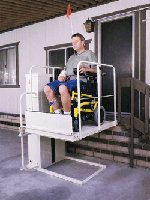 Wheelchair lifts provide a much more low profile solution and are basically mini-elevators. The technical name for a wheelchair lift is a vertical platform lift, which describes how these devices work. The wheelchair lift is placed next to the landing of the front porch, with a platform rising vertically from the ground to the front porch.
Wheelchair lifts provide a much more low profile solution and are basically mini-elevators. The technical name for a wheelchair lift is a vertical platform lift, which describes how these devices work. The wheelchair lift is placed next to the landing of the front porch, with a platform rising vertically from the ground to the front porch.
While vertical platform lifts are similar in concept to an elevator, the entire unit is self-contained, so with the exception of providing a sturdy base for the lift, there is little modification to the structure of the home. The base can be made of wood or concrete, with proper drainage being very important. When considering the placement of the wheelchair lift, it is important to take into account how water drains off the roof, because you do not want it draining directly onto the lift, even though wheelchair lifts are weather resistant.
The main advantage of a vertical platform lift, other than the small amount of space it takes up, is that it provides a virtually effortless means of entering the house. The user need only drive their wheelchair onto the platform and push a button, with the lift doing the rest of the work.
From a cost perspective, vertical platform lifts do usually cost considerably more than wooden wheelchair ramps. However, with the high price of modular metal wheelchair ramps, there is not always as large of a price difference between wheelchair lifts and metal wheelchair ramps.
Vertical Platform Lifts and Inclined Platform Lifts
September 22nd, 2009
For those who use electric wheelchairs or other types of mobility vehicles, ensuring that the home is wheelchair friendly is incredibly important. There are many things that can decrease accessibility, such as narrow doors or raised door frames, but of all areas in a home, often the front steps present the largest hurdle.
Since building a wheelchair ramp takes up a lot of the front yard, with the same being true of modular metal wheelchair ramps, which are more expensive, many wheelchair users turn to vertical platform lifts to increase accessibility.
How Vertical Platform Lifts Work
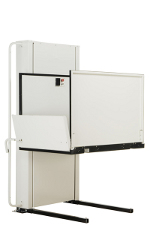 Vertical platform lifts are often called wheelchair lifts or porch lifts, as they are most often seen on the front porch of a home. In many ways, vertical platform lifts are very similar to elevators, however unlike an elevator, a vertical platform lift is a completely self-contained unit. The lifting system, lifting shaft, and lifting platform are basically a single unit, which can simply be placed next to a staircase, typically without having to preform any major modification to the home.
Vertical platform lifts are often called wheelchair lifts or porch lifts, as they are most often seen on the front porch of a home. In many ways, vertical platform lifts are very similar to elevators, however unlike an elevator, a vertical platform lift is a completely self-contained unit. The lifting system, lifting shaft, and lifting platform are basically a single unit, which can simply be placed next to a staircase, typically without having to preform any major modification to the home.
Porch lifts work by raising a metal platform from the ground to the staircase landing. The porch lift is placed directly next to the staircase landing and rises vertically. Most have a base lifting height of about 4 feet, which can then be upgraded as needed.
The shaft of the wheelchair lift is designed with stability and weight capacity in mind. It is not uncommon for a wheelchair lift to support more than 700 pounds, so multiple people can use it at once, or the device can be used to make bringing groceries or furniture into the home.
The platform of most wheelchair lifts is surrounded to prevent rolling off of the lift while it is in motion. Many also include locking gates for the top landing, which can greatly reduce the risk of a fall. These types of safety gates and doors are often a requirement for commercial wheelchair lifts.
Using a Wheelchair Lift Indoors
As a result of how these devices are used, vertical platform lifts work incredibly well on the front porch of a home, but will not work with many residential indoor staircases. The exception being schools, churches, and other commercial buildings, where vertical platform lifts are often well suited for indoor use. Whether the wheelchair lift can be used indoors depends on if the lift can be placed next to the landing and rise high enough to reach it. Most wheelchair lifts have a maximum lifting height of 12 feet.
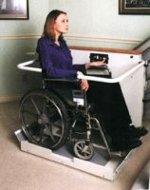 Instead, for indoor use, an inclined platform lift is often a better choice to increase wheelchair accessibility. Inclined platform lifts use a metal track that is attached to the wall of the staircase, running its entire distance. A car, which consists of a large platform and is surrounded by a protective gate, moves along the track, carrying a single wheelchair user.
Instead, for indoor use, an inclined platform lift is often a better choice to increase wheelchair accessibility. Inclined platform lifts use a metal track that is attached to the wall of the staircase, running its entire distance. A car, which consists of a large platform and is surrounded by a protective gate, moves along the track, carrying a single wheelchair user.
Inclined platform lifts can be pretty large though, so on narrower staircases, they might not work. However, when not in use, the inclined platform lift can be folded, so the staircase can still be used.
Increasing Accessibility With Wheelchair Ramps and Vertical Platform Lifts
September 18th, 2009
One of the most common dilemmas faced by those who use wheelchairs and mobility scooters is how to safely and easily move these devices into and out of the home. There are several popular options, which include installing a wheelchair ramp or using a vertical platform lift.
Wooden Wheelchair Ramps
 Wheelchair ramps are often found in commercial settings made out of poured concrete, but they are also popular in residential settings. For use in homes, the concrete wheelchair lift is not as popular though, with most people using a wooden wheelchair ramp or a modular metal wheelchair ramp.
Wheelchair ramps are often found in commercial settings made out of poured concrete, but they are also popular in residential settings. For use in homes, the concrete wheelchair lift is not as popular though, with most people using a wooden wheelchair ramp or a modular metal wheelchair ramp.
In the case of wooden ramps, a number of plans are available, which can built by those who are reasonably handy with tools and knowledgeable with woodwork. There are usually a number of local handymen who can be hired to build a wooden wheelchair ramp as well.
It is important to invest in quality treated lumber, which will be able to withstand water and the elements. While a wooden wheelchair ramp is usually less expensive, the lumber and other building supplies can quickly add up.
Modular Metal Wheelchair Ramps
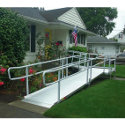 Modular metal ramps are also popular, as they only need to be fitted together at the home, greatly reducing the installation time and cost. However, a modular metal ramp typically costs a good deal more than it would cost to build a wooden wheelchair ramp. It is more durable though and many like the shiny metal look over the wooden feel offered by a wooden wheelchair ramp.
Modular metal ramps are also popular, as they only need to be fitted together at the home, greatly reducing the installation time and cost. However, a modular metal ramp typically costs a good deal more than it would cost to build a wooden wheelchair ramp. It is more durable though and many like the shiny metal look over the wooden feel offered by a wooden wheelchair ramp.
Threshold Ramps
When deciding what type of ramp to purchase, it is important to consider whether a full ramp is needed or simply a threshold ramp. For very short distances, a threshold ramp can be a very cost effective type of wheelchair ramp, which is basically a metal plank that attaches to the door frame and can usually bridge a few steps. However, a threshold ramp will only work on very short distances.
Drawbacks of Using a Wheelchair Ramp
While wheelchair ramps can be cost effective, they have two major drawbacks. One is the amount of space they take up in the yard. The length of the ramp is directly related to the height of the staircase, so in many cases, a wheelchair ramp will have to be very long, taking up a good deal of real estate on the lawn. Not only can this be a drawback when it comes to how the home looks, but for those with animals or small children, this loss of yard space can greatly affect how the home is used.
The other main drawback is that even though the incline is not very large, you still must move the wheelchair up what is essentially a hill when you use a wheelchair ramp. In the case of some older wheelchair users and those who use manual wheelchairs, this might not be possible. Even if you have someone to push the person up the ramp, it can require a great deal of effort and there are some risks associated with wheelchair ramps.
Vertical Platform Lifts
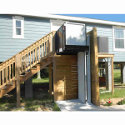 Another option for those who use mobility vehicles, like wheelchairs and electric scooters, is the vertical platform lift. Vertical platform lifts are also called wheelchair lifts and provide what is essentially a mini-elevator that is installed next to the front steps. A metal platform, of varying size, is provided for the wheelchair user to drive onto. When activated, the platform rises upwards until it is parallel with the front steps.
Another option for those who use mobility vehicles, like wheelchairs and electric scooters, is the vertical platform lift. Vertical platform lifts are also called wheelchair lifts and provide what is essentially a mini-elevator that is installed next to the front steps. A metal platform, of varying size, is provided for the wheelchair user to drive onto. When activated, the platform rises upwards until it is parallel with the front steps.
While in functionality a wheelchair lift is very similar to an elevator, the entire unit is self contained, so there is no need to build an elevator shaft or worry about running any cables. Instead, once the wheelchair lift is assembled, it can simply be placed where it is needed and turned on, instantly bridging the gap between the ground and the front steps.
These devices are also called porch lifts, because they are usually used on the front porch of a home, but they are also popular in schools and other commercial buildings.
Porch lifts include a number of safety settings, with doors available for both the top and bottom of the staircase. This can be important, because to install a porch lift it is usually necessary to remove a section of the handrail at the top of the landing. A door with call button at the top of the landing can serve as a gate, preventing falls when the porch lift is at the bottom of the staircase.
Vertical platform lifts are very popular because they are easy to install and do not take up much space. As a result, they can be used in many areas where a wheelchair ramp would not fit or would take up too much yard space. These wheelchair lifts are also quite powerful, with most supporting around 700 pounds and can span distances of up to 12 feet. In some cases where the porch is very high off the ground, the amount of space required to make a wheelchair ramp would be very excessive, where using a wheelchair lift requires only a few feet.
Due to their weight capacity, wheelchair lifts can also be used as service elevators, making moving heavy objects up the stairs much easier. It is also not uncommon for two people to use the porch lift at once, with one in a wheelchair or mobility scooter and the other behind them.
Wheelchair lifts do, however, cost more than most wheelchair ramps, although this is not always the case with modular metal wheelchair ramps, which can end up being pretty expensive as well.
Choosing Between a Manual Wheelchair and a Power Chair
September 15th, 2009
In today’s world, the choice of manual or electric often gets looked upon as an easy choice, with power almost always getting looked upon as the easier and more efficient solution. This can be seen in most peoples choice of power tools, power windows, and power steering. However, in the world of manual and electric wheelchairs, the choice is not so straightforward or easy, as both have advantages and disadvantages.
A Look Back at the History of the Wheelchair
Wheelchairs have been used for thousands of years, with images being found that indicate ancient Asians were among some of the first to make use of a wheelchair for those who had difficulty walking. During the middle ages, wheelchairs would be relatively common, but because they had to be custom made, they were almost only available to those who had the resources to build them, such as figures of nobility.
It would not be until much later during the early nineteenth century that wheelchairs would take on a more standard design, using a simple foldable lightweight steel tube frame. Today, this same design remains incredibly popular among manual wheelchairs and electric wheelchairs are also very common, with an electric motor concealed in a base made of molded plastic and a seat attached to the base of the wheelchair.
Choosing the Right Wheelchair: The User
One of the first , and arguably most important, steps in deciding whether to use a manual wheelchair or an electric wheelchair revolves around the physical abilities of the wheelchair user. It takes a great deal of physical effort to use a manual wheelchair and this can put a great deal of stress on the upper-body. As a result, using a manual wheelchair can be very strenuous, too much so for many
There is of course also something to be said for personal preference, as many people enjoy using a manual wheelchair precisely because it requires more physical effort. There are a number of sports, such as wheelchair basketball, wheelchair tennis, and wheelchair racing, which make extensive use of manual wheelchairs as well and many wheelchair users prefer the feeling of independence and flexibility that is offered by using a manual wheelchair. .
Choosing the Right Wheelchair: The Location
While the physical condition of the wheelchair user is one of the most important considerations, the location where the wheelchair will be used is also important. For example, if the wheelchair is primarily going to be used around home, then it will require much less upper-body strength to use than if it were to be used around a college campus. As a result, for home use, many people prefer the simple and less complicated design of a manual wheelchair.
However, those that will be using the wheelchair across larger distances, such as around town or driving around the neighborhood, might be better served with an electric wheelchair.
Choosing the Right Wheelchair: The Cost
One of the other major considerations when choosing between an electric wheelchair or a manual wheelchair is the cost of the device. While it is possible to spend a great deal on a manual wheelchair, they still typically cost a great deal less than an electric wheelchair. For those who are unable to get a Medicare wheelchair, Medicaid Wheelchair, or other insurance discount, an electric wheelchair might simply not be affordable.
A Look at Mobility Scooters and Their Uses
September 14th, 2009
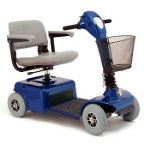 The mobility scooter has actually been around for almost fifty years, but it did not gain popularity until the end of the twentieth century. This was in part because the cost of mobility scooters was much greater until that point. Perhaps the Rascal Mobility Scooter is the most well known, which helped bring these devices to the publics conscious, but today, mobility scooters are more popular than ever.
The mobility scooter has actually been around for almost fifty years, but it did not gain popularity until the end of the twentieth century. This was in part because the cost of mobility scooters was much greater until that point. Perhaps the Rascal Mobility Scooter is the most well known, which helped bring these devices to the publics conscious, but today, mobility scooters are more popular than ever.
Mobility Scooter Design and Their Differences from Electric Wheelchairs
Mobility scooters are in many ways similar to electric wheelchairs, with many of the popular mobility scooter manufacturers, such as Pride Mobility Scooters and Golden Mobility Scooters, offering both types of devices. As a result, they share many of the same components and electrical systems, but the actual layout of a mobility scooter is much different from an electric wheelchair. It is this difference in design, which makes the purposes of electric wheelchairs and electric scooters much different.
The basic difference is that a mobility scooter has a much longer base, often more than 5 times as long as an electric wheelchair. The user is positioned towards the rear of the electric scooters base and a tiller, which is basically a set of handlebars, is installed on the front of the scooter. As a result of the longer base and the tiller, a mobility scooter is not something you could drive up directly to a table or desk as you would an electric wheelchair. Instead, it would be necessary to transfer to a chair or drive the scooter up parallel to the table, although the latter will often not allow the user to make full use of the table.
With the difference in design between electric wheelchairs and electric scooters comes a difference in target markets. Most of those who use mobility scooters are able to walk for short distances, but have difficulty walking for extended periods. This makes them very popular among seniors, who might not otherwise be able to fully use their home, go shopping, or spend time with their family. Some people who use wheelchairs, however, do enjoy using mobility scooters for outdoor use though, especially heavy duty mobility scooters, which can be driven pretty much anywhere.
With the similar functions of electric wheelchairs and mobility scooters, it begs the question, why don’t people just use electric wheelchairs. There are several answers to this, but cost is often a leading factor, as most mobility scooters cost considerably less than the average electric wheelchair. Mobility scooters are also often better suited for longer distances and rougher terrains.
Mobility Scooter Manufacturers
There are many electric scooter manufacturers, but those manufactured by Pride Mobility and Golden Technologies are the most common, with both of these companies having been involved in the mobility vehicle industry since the early nineties. There are a number of lesser manufacturers as well, but the quality of Pride Mobility Scooters and Golden Mobility Scooters is well known and respected. These companies both also offer comprehensive warranties on their scooters.
ShopRider is another popular company, although they lean more towards the budget end of the spectrum and are often not as durable as Pride Scooters and Golden Scooters. Drive Medical is another mobility scooter manufacturer, who is most well known for their manual wheelchairs, although they also offer a number of other medical devices.
There are also a number of no-name mobility scooters available, often from manufacturers in China. These usually cost a great deal less, but are not made to the same high standards as the well known mobility scooter manufactures, are prone to failure, and are usually not covered by a very comprehensive warranty.
A Look at Wheelchair Development
September 11th, 2009
Mobility vehicles of some shape or form have been around for hundreds and thousands of years. These devices are important tools for increasing accessibility and allowing those who have difficulty walking to get around.
Early Wheelchair Design
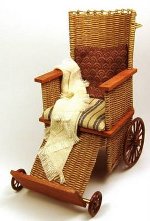 In the early days, there was no standard to these devices and often they were only affordable by nobility. It was also not uncommon for the kings and other royalty who used these early wheelchairs to need them more as a result of their lavish lifestyle, rather than out of a practical need.
In the early days, there was no standard to these devices and often they were only affordable by nobility. It was also not uncommon for the kings and other royalty who used these early wheelchairs to need them more as a result of their lavish lifestyle, rather than out of a practical need.
This began to change towards the end of the nineteenth century, when a wicker wheelchair was designed. The wicker wheelchair had a very high back and sides, with two wheels on the side and one in the back. Due to its large size and the design of its wheels, it was very hard for a wheelchair user to self propel this type of wheelchair or even to transport it away from the hospital. Still, it was much more effective than previous designs and was adopted across the United States by most hospitals.
The Development of the Folding Self-Propelled Wheelchair
 The wicker wheelchair had a number of design problems that made it very difficult for the average wheelchair user to use. As a result, two inventors, one of whom was in a wheelchair, worked together to develop a lightweight foldable wheelchair. Their design, which is known as the E & J wheelchair, made use of a frame made out of hollow steel tubes, which provided a great deal of support and strength, but without the same weight as that of a wicker wheelchair. The steel tube frame could also be folded up, making the wheelchair much easier to transport.
The wicker wheelchair had a number of design problems that made it very difficult for the average wheelchair user to use. As a result, two inventors, one of whom was in a wheelchair, worked together to develop a lightweight foldable wheelchair. Their design, which is known as the E & J wheelchair, made use of a frame made out of hollow steel tubes, which provided a great deal of support and strength, but without the same weight as that of a wicker wheelchair. The steel tube frame could also be folded up, making the wheelchair much easier to transport.
At the time the E & J wheelchair was invented, America was on the precipice of the Second World War and so the wheelchair was put to great use. The development of antibiotics meant that soldiers were able to recover from wounds that even only a few short years ago would have been fatal, with many soldiers returning from the war without full use of their legs.
The E & J wheelchair would remain the standard for some time and the first electric wheelchairs were built around its frame. A number of companies began to sell converter kits that allowed the E & J wheelchair to be inexpensively converted to an Electric Wheelchair. These made use of a simple electric motor that could be attached to the axle of the wheelchair and controlled by a simple joystick placed on the wheelchair’s arm. While the design of a modern electric wheelchair is much different, the joystick control scheme is the standard for most electric wheelchairs. However, there are also a number of other control systems available for those who can not use a joystick.
Today, the basic design of the E & J wheelchair has remained the same and can be seen in most modern manual wheelchairs, although there are many other popular wheelchair manufacturers.
Manual or Electric, Not Just a Question for Tim Taylor
September 9th, 2009
For those wheelchairs, often one of the most important decisions is whether to choose a manual wheelchair or an electric wheelchair. There are a number of factors that go into this decision and it is important to spend some time considering what type of wheelchair will best fit the needs of the wheelchair user.
A Brief Look at the Development and History of the Wheelchair
Wheelchairs have been around for thousands of years, albeit in a much less standard design than what we are used to today. Early wheelchairs were often custom made and during the middle ages, they were often a byproduct of the gratuitous lifestyle of nobility, who were able to afford to have a smith custom build a wheelchair. As time went on, several designs would come and go. Prior to the metal tubed lightweight foldable wheelchair common today, a wicker wheelchair became popular. These had a very high back and three wheels, with two on either side and one in back for support. While these kinds of wheelchairs were very popular and common during the turn of the twentieth century and even up until the 1940′s, the wicker wheelchair left a lot to be desired, because it could not be easily self propelled.
Today, a great deal of thought and design has gone into the manual wheelchair, making it very efficient and lightweight. Electric wheelchairs are also very common and include an electric motor and rechargeable battery to quickly and easily move an individual across many types of terrain.
Choosing the Right Wheelchair
Choosing between an electric wheelchair and manual wheelchair should not be a decision that is taken lightly and there are in fact a number of things that must be taken into consideration.
The Abilities of the Wheelchair User
One of the most important things to consider when deciding between a manual wheelchair or an electric wheelchair is how well an individual will be able to use a manual wheelchair.
Due to disease, illness, or injury, it may not be possible to use a manual wheelchair, because using a manual wheelchair can be very strenuous. As a result, in many cases, due to the physical abilities or the wheelchair user, using a manual wheelchair may simply be out of the equation. In these cases an electric wheelchair may be a better choice and there are a number of alternate control systems available that make using a wheelchair much easier, such as allowing the user to control it with head.
However, many people enjoy manual wheelchairs for just this reason and enjoy the physical effort required to use it. There are many wheelchair sports that are becoming increasingly popular, such as wheelchair racing and wheelchair rugby. So, for a number of wheelchair users, the physical effort required to use a manual wheelchair is looked on as a benefit. Manual wheelchairs are also much more responsive, in that the wheelchair user ultimately has a great deal more control over the wheelchair, which is a big benefit for many, just as many people prefer manual vehicles over automatics.
Where the Wheelchair Will Be Used
The place and location that the wheelchair will primarily be used is also an important thing to think about. If the wheelchair is going to be primarily used in the home, then using a manual wheelchair will require a great deal less effort than if it were to be a mode of transportation across a college campus. If on the other hand, the wheelchair will be used away from home, an electric wheelchair, which often has a per-charge range of over 15 miles, might be a much more efficient and practical choice.
Determining how and where the wheelchair will be used is important. It is also important to consider how the wheelchair will be transported though, because a manual wheelchair can be folded up and placed in the back seat of a car or the trunk with little problem. Transporting an electric wheelchair is not usually as easy and typically requires a vehicle wheelchair lift.
The Cost of the Wheelchair and Wheelchair Accessories
As is usually the case, it is also important to consider cost when deciding whether to use a manual wheelchair or an electric wheelchair. If it is possible to get a Medicaid Wheelchair or a Medicare wheelchair, then the cost of the wheelchair will be greatly reduced, with the insured usually only responsible for 20% of the cost.
However, if insurance is not an option, than an electric wheelchair can be very expensive, at least in comparison to a manual wheelchair. Even a top end manual wheelchair is usually much less expensive than a power chair, so it is important to consider your budget.
When considering cost, it is also important to consider operating cost, as a power chair will require periodic replacement batteries, usually once every 12 to 18 months, depending on use. Power chairs also usually require a vehicle wheelchair lift to make transportation easier, so if it will be used away from home, this could be an additional cost. It may also be necessary to install a wheelchair lift or a wheelchair ramp at home, which in reality is probably needed for both power chairs and manual wheelchairs, although it is most assuredly needed to move a power chair into and out of the house, as electric wheelchairs are much heavier than manual wheelchairs.
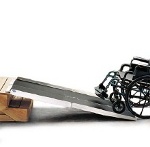 For very short staircases, of only a few steps, a simple metal ramp is the easiest and least expensive option. These come in a variety of designs, but are usually between 3′ and 6′ long. The ramp, which is made out of lightweight metal and usually has a non-skid textured backing, is simply placed onto the landing of the staircase, with some offering lightweight clamps that help hold the ramp in place. The wheelchair user can then drive up or down the ramp, which can be set up or removed in minutes.
For very short staircases, of only a few steps, a simple metal ramp is the easiest and least expensive option. These come in a variety of designs, but are usually between 3′ and 6′ long. The ramp, which is made out of lightweight metal and usually has a non-skid textured backing, is simply placed onto the landing of the staircase, with some offering lightweight clamps that help hold the ramp in place. The wheelchair user can then drive up or down the ramp, which can be set up or removed in minutes.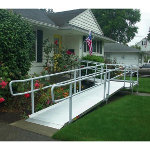 For larger staircases, a much larger wheelchair ramp is required. These often are custom built out of wood, with many free wheelchair ramp plans available online. Wooden wheelchair ramps are usually a fairly cost effective option and can be built by most handymen. It is also usually possible to hire most carpenters to build a wooden wheelchair ramp.
For larger staircases, a much larger wheelchair ramp is required. These often are custom built out of wood, with many free wheelchair ramp plans available online. Wooden wheelchair ramps are usually a fairly cost effective option and can be built by most handymen. It is also usually possible to hire most carpenters to build a wooden wheelchair ramp. 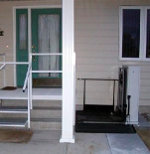 Wheelchair lifts are also a popular choice for those who use mobility scooters and electric wheelchairs, with these devices being very similar to an elevator in the way they work. The wheelchair lift, which is referred to as a vertical platform lift in the home medical industry, is placed next to the landing of the staircase, raising and lowering the wheelchair user on a metal platform.
Wheelchair lifts are also a popular choice for those who use mobility scooters and electric wheelchairs, with these devices being very similar to an elevator in the way they work. The wheelchair lift, which is referred to as a vertical platform lift in the home medical industry, is placed next to the landing of the staircase, raising and lowering the wheelchair user on a metal platform.